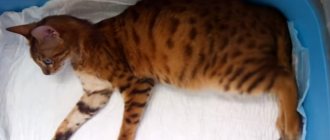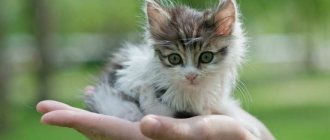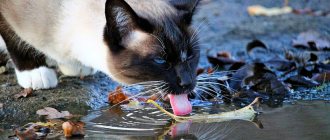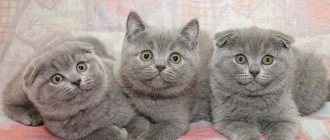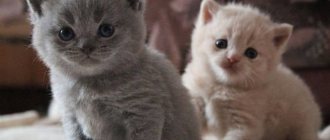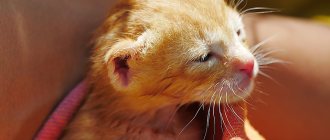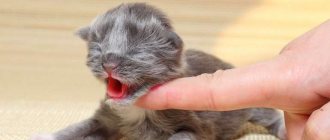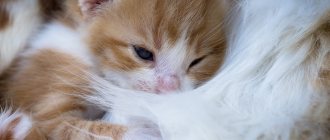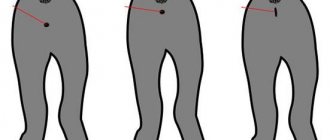Why you can’t pick up a kitten early
It is not advisable to separate Bengal kittens from their mother before 3 months. It is better to choose a baby who is 3.5-4 months old.
There are several reasons for this:
- Bengal kittens usually already have all the necessary vaccinations. The future owner saves himself from additional hassle.
- At 7-8 weeks, the baby is not yet ready to eat exclusively solid food, which can cause digestive problems.
- Bengal kittens raised on their mother's milk acquire excellent health and strong immunity.
- In the first months after birth, an adult cat introduces kittens to the outside world, teaches them how to wash themselves properly, how to use a tray and a scratching post. Babies are formed mentally, emotionally, physiologically and mentally.
- At 12-14 weeks, Bengals can more easily tolerate separation from their mother and a change of place of residence.
Pets that are taken from their mother early often become distrustful. In this case, an adult cat does not have time to instill in them the correct model of behavior and teach them how to communicate with people.
What to feed a Bengal cat
Bengal cats have quite sensitive digestion, so their diet must be treated with special attention. There are two possible options for feeding Bengals: natural and industrial food.
Industrial feed has a number of advantages:
- Long shelf life.
- A perfectly balanced diet.
- The food includes all the necessary minerals and vitamins.
- No need to waste time shopping for groceries and cooking.
A Bengal cat can only be given premium and super-premium food. Economy class food is of low quality and contains flavoring additives and dyes.
The natural diet of a Bengal cat should include the following components:
- Lean meat (chicken, turkey, rabbit, veal).
- By-products (liver, heart, lungs, kidneys).
- Fresh and boiled vegetables.
- Low-fat cottage cheese.
- Bran.
- Sea fish fillet.
A natural-fed cat must be given vitamin and mineral supplements.
Bengals should not be fed from the table. List of prohibited products:
- sweets (especially chocolate, which is poisonous to cats);
- flour;
- salt and spices;
- tubular bones;
- potatoes and legumes;
- milk for a cat older than 4 months.
Advantages and disadvantages of the breed
| Advantages | Flaws |
| Unique appearance. | Most Bengals do not like to be picked up or hugged. |
| Loyalty to the owner and friendliness. | Excessive activity. This breed may not be suitable for calm people. |
| Love for children, and patient attitude towards other pets. | Price. |
| High intelligence and good ability to learn tricks and commands. | The Bengal constantly needs the attention of its owner; it cannot be left alone for a long time. |
How do little Bengals grow?
From a tiny lump grows a luxurious spotted short-haired animal with an affectionate domestic character. Sociable and intelligent cats quickly become attached to humans and require attention from the first day of their life. With proper care and nutrition, they grow quickly, turning into a luxurious animal. You can fall in love with this handsome spotted cat at first sight. Purebred Bengal cats respond to humans with love and devotion.
First month
A mini-leopard is born very tiny, weighing only 90-120 g. Sometimes very small kittens appear, viable individuals weigh more than 60 g. The weight largely depends on how many kittens are in the litter. They actively feed on colostrum and breast milk, build up immunity, and grow quickly. At 2 weeks the kitten will double its weight, and by the end of the fourth week it will weigh 400-700 g. If the pet is too thin, it will need additional attention.
After about ten days, hearing will appear, and after a few more days the kittens open their eyes. All these events will end by the end of the second week. Now the skeleton is strong enough, crawling and standing exercises begin. By the end of the third week, he can already sit and tries to walk carefully. A one-month-old Bengal's baby teeth appear and he begins to bite, scratch, and play. You can already determine the gender.
“When a newborn kitten is gaining too little weight, the diet of the nursing mother needs to be checked and adjusted.”
Second month
The kitten is strong enough to actively explore the world around him, plays a lot, runs around, but always returns to his mother - the source of food, warmth, and care. Particular entertainment is jumping from relatively high surfaces. It is necessary to limit access to potentially dangerous places, because the pet does not yet know how to correctly assess height. He is growing rapidly, at 2 months the weight reaches 1300-1500 g, mother's milk is no longer enough. It's time to introduce complementary foods and carry out deworming.
Third month
At 3 months, the kitten continues to develop; it has already completely switched to artificial nutrition. Time of first vaccinations. The color of the spotted coat, dark or white, naturally fades - this is phasing. The eyes are usually gray-blue, the color of the iris is formed. By the end of the month, the little Bengal already weighs about two kilograms.
He becomes even more active and restless. Security measures remain in effect. At this time, you need to communicate more with the kitten, educate it, because it is already ready to move to a new home. By this point, the pet should be accustomed to the tray.
“If the kitten is not gaining weight as rapidly after eight weeks as before, there is no need to worry. This is a normal change in growth dynamics for Bengals.”
Fourth month
The kitten becomes even more active, but remains not too careful. Security measures cannot be relaxed. The kitten is trained to use a scratching post. The color of the eyes changes, it has already formed, and phasing enters its final stage. If the move to a new house has taken place, the owner should constantly check the condition of the premises where the new family member lives.
Weight dynamics of Bengal kittens:
| Age | Approximate weight, g |
| In the first week | 70-120 |
| First month | 400-500 |
| 2-3 months | 500-2400 |
| 4-5 months | 2700-3600 |
| 5-6 months | 2900-3900 |
| 7 months | 4000 |
| 8-9 months | 4100-6000 |
| 10-12 months | 4200-6000 |
Narrow loopholes where the kitten can get stuck, wires, and other objects that can be chewed are unacceptable. Baby teeth are replaced by permanent teeth; for play, objects are needed that cannot be broken in order to partially swallow. Everything glassy, fragile, and breakable should be removed from the sphere of interests of a purebred pet. Puberty begins.
From five months to a year
From the time a kitten begins to change teeth, its immunity weakens somewhat. This continues for up to seven months. At about six months it is necessary to get a rabies vaccination if recommended by a veterinarian. After the cat appears in heat, you need to decide on her sterilization. This is a necessary measure for individuals not involved in breeding.
Males are castrated, if necessary, at seven or eight months, when they weigh four kilograms. It happens that a sexually mature kitten constantly yells, demanding a date with the cat. The problem needs to be resolved as early as possible to reduce stress for all residents of the house and for the Bengal itself.
By the end of seven months, the pet’s active growth is completed. He gains approximately 80% of his final weight, which will be gained at about two years of age and will be 6-8 kg. Female cats stop growing earlier than female cats, at about 5 months.
Tips for choosing
The basic selection rules will be as follows:
- Selecting a generation of kittens. Basic Bengal cats of the early generation F1 are not recognized as pets - they are intended for breeding. SBTs are suitable - Bengals, purebred animals, all of whose relatives in four generations were Bengal cats.
- Decide which wool pattern you like best. The coat color can be rosette or marbled, and the main coat colors are brown and white, there are golden and cream variants, and the shimmering shine is called glitter.
- Selecting a breeder based on recommendations and reviews.
- Inspection of litter, background check of parents.
- Preferences in choosing gender - male or female.
- A thorough examination of the future pet.
Following the subtleties of choice will help you find the ideal pet and minimize the stressful period when adapting to new living conditions.
When all the requirements are met, follow your intuition and sympathy when choosing your future spotted pet. Compliance with the rules of maintenance and care will significantly extend its lifespan, and your Bengal pet will spend years with you filled with sincere friendliness and love.
1. Health. It is most important. Cats and kittens must have up-to-date VACCINATIONS. Don't hesitate to ask for your cat's veterinary passport. The cat owner must show you the cat's TESTS (coronavirus, viral leukemia, feline immunodeficiency virus, chlamydia (dangerous to humans) and a copy of the cat's tests. If there are no tests, then we can say that you are buying a “pig in a poke.” If the breeder is so careless to the health of his cat - the producer, then there are no guarantees that the kitten does not have worms, fleas, ear mites and other diseases. Not a single good cat in St. Petersburg will take a cat for mating without tests. If the cat was bred with a quality cat, tests should be . Of course, any breeder will claim that his cat is healthy, but whether to believe his words or not is your choice. Not a single kitten in the litter should have discharge from the eyes or nose. Look in the ears, under the tail, it should also be clean . If there is discharge, run away from such kittens! The kitten should be strong, large, feel the tail, it should be even. 2. Character, upbringing. Understanding the character of a kitten and its upbringing is difficult, but it is possible! You just need to be careful. Pay attention to the conditions in which the kittens and cat are kept. If the room has not been renovated for a long time, you can immediately turn around and leave; in such a place it is not possible to buy a high-quality Bengal. Or the kittens are locked in an isolated room (balcony, cage, toilet, kitchen), then there is a very high probability that the kitten is not accustomed to anything. Most likely, kittens pee “in the wrong place” and tear up walls and furniture. That's why they are not allowed everywhere, so as not to damage property. If kittens run freely around the apartment and jump on the scratching post in front of you, these are well-behaved kittens.
How do Bengals develop?
| Days, months | Events, activities |
| 5-8 days | The ear canal opens |
| 7-12 days | Eyes open |
| 12-21 days | The first teeth appear |
| 13-16 days | Ability to navigate by sound |
| from 14 days | Vision becomes clearer |
| from 18 days | First claw trimming Ability to stand on paws |
| 21-30 days | Learn to walk ; Fang trimming and deworming if necessary |
| from 30 days | Start of complementary feeding, toilet training |
| 5-10 weeks | Routine prevention of helminths Immunity borrowed from the mother weakens |
| 6-16 week | Vaccination |
| 8-12 week | Revaccination |
| 3 months | Moving to a new home |
| 12-14 week | Permanent teeth appear, immunity decreases |
| 3.5-7 months. | Routine vaccination |
| 6 months | Puberty |
| 4-20 months | Sterilization, castration |
“Gaining excess weight is not common in Bengal kittens, but if it happens, you should contact your veterinarian.”
Bengals. Beware of “counterfeits” or “All that glitters is not gold”!
Despite its youth - just over half a century has passed since the very idea of creating this breed appeared - the Bengal breed is perhaps one of the most popular in the world today. The reason for this popular love lies, first of all, in the unusual color of these animals: there is hardly at least one person who will be indifferent to the unimaginably beautiful, sparkling pattern of the Bengals. This is true beauty, gifted to the Bengal by nature itself and carefully preserved by the best breeders of the breed.
But, like everything popular, the Bengal breed cannot avoid “fakes.” A fashionable gadget comes out and its “Asian twins” immediately appear; a top fashion designer releases a collection of clothes - and almost on the same day, “new items” from the catwalks fill the shelves of obscure stores... But if a substandard gadget, crooked stitching on a bag or a poor-quality print on fabric is immediately visible, then you can distinguish a real Bengal from a “fake” much more difficult. Unfortunately, there are people who buy mediocre representatives of the breed - to make it “simpler, cheaper.” And if such kittens are bought, as they say, “for love,” it’s not so bad; The real problem is if such an owner imagines himself as a “breeder” and begins to distribute the descendants of low-quality animals. Alas, this happens, and this can lead to erosion of breed characteristics and a general decrease in the quality of the Bengal breed. This absolutely cannot be allowed, so when choosing a kitten, remember: there are no real Bengals “for three pennies.” They simply do not exist, and this is an axiom.
So how can you distinguish real “Bengal gold” from what “just glitters”? Let's start from the very beginning. The Bengal breed was conceived and created to replicate the appearance of the wild Asian leopard cat, but with a “domestic” temperament. Jane Mill, who is considered the founder of the breed, took it up essentially out of compassion. While on a business trip in Bangkok, Jane, then with her maiden name Sugden, saw charming Felis Bengalensis, or ALC, kittens at a local market, similar in size to ordinary house cats, but “wearing” fur coats of such incredible beauty that Jane’s heart fluttered. Moreover, this species of animals native to Southeast Asia at that time was on the verge of complete extinction, and unscrupulous businessmen sold the babies in markets to visiting Europeans and Americans as living souvenirs. Trying to preserve this incredible beauty for people, Jane bought a lovely Asian leopard cat, named her Malaysia and crossed her with a black domestic cat at home in the USA.
However, due to objective circumstances, work on the creation of the Bengal breed was interrupted for 20 long years, and only in the early 80s of the last century was Jane Mill able to return to creating the cat of her dreams. And finally, in 1991, incredible gentle domestic cats of wild leopard color first appeared at the TICA exhibition. And they conquered everyone. Following Mrs. Mill, other American breeders became interested in breeding the breed and creating its unique appearance and temperament, devoting more than a decade to the result that Bengal fans see today. After all, a true Bengal is a unique breed from the nose to the tip of the tail!
Bright, impetuous, elegant, dexterous, strong, loving, intelligent, active... One can endlessly continue the series of admiring descriptions of Bengals. Once you see them, you will no longer be able to resist this breed. And it doesn’t matter whether you have only one Bengal at home or unnoticed))) you have become a breeder of this breed with a number of cats that will shock the average person. They enter human hearts immediately and confidently occupy every corner there: love for Bengal is love at first sight).
What are these cats like from the point of view of felinological science? A real Bengal is a large cat with a muscular build, with the gait and habits of a real hunter. Everything about Bengals shows that they belong to wild ancestors: this is the special structure of the head, the love of water, the extraordinary plasticity and grace characteristic only of wild cats, and the fantastically beautiful color.
It is the color that attracts many people to Bengals, and this is completely justified! Delicate to the touch, silky wool is extremely rich in color shades. Whether it is rosettes (like those of leopards or cheetahs), or a “special” marble pattern characteristic only of this breed, the tone of the coat is always distinguished by its extraordinary richness and characteristic radiance - glitter, and the pattern is clear, with a horizontal orientation. It should be emphasized that there are no two Bengals in the world with the same pattern: like human fingerprints, the pattern on the fur of each animal is strictly individual.
The most common color is black tabby. But this is not the “classic” black tabby color found in other breeds: the shades of black tabby color in Bengals range from a cool grayish hue to exciting shades of gold, bronze and even a noble shade of mahogany.
Nowadays, so-called “snowy” Bengals appear more and more often at exhibitions, the color of which – namely the point and Burmese colors – is associated with certain forms of albinism. In these colors, the coat has an ivory or “light tan” tint, and along the body there is an equally expressive pattern (rosette or marble), which has shades from light brown to the color of dark chocolate. The eyes of a cat can be either characteristic blue for point colors or aquamarine for mink colors.
What are nurseries?
Nurseries are breeders who have verified and selected producers: males and females. Such establishments must be registered in felinological systems and clubs. Only a nursery with such registration can guarantee that breed standards are strictly observed and that buyers of kittens receive 100% “Bengalis”.
An important advantage of nurseries is that they make sure that the kittens are genetically healthy. Like all selective breeds, the Bengal cat breed is susceptible to a number of genetic diseases. Therefore, it is important that producers are tested for hereditary diseases. In a trusted nursery, two carriers of mutated genes are never crossed to avoid producing sick offspring. The results of genetic research are simply necessary for the breeder for breeding work. Cats from the cattery always participate in exhibitions and other similar events. If you want to buy an animal that is ready for different shows and accustomed to the public, then there is simply no better place to buy than a nursery.
